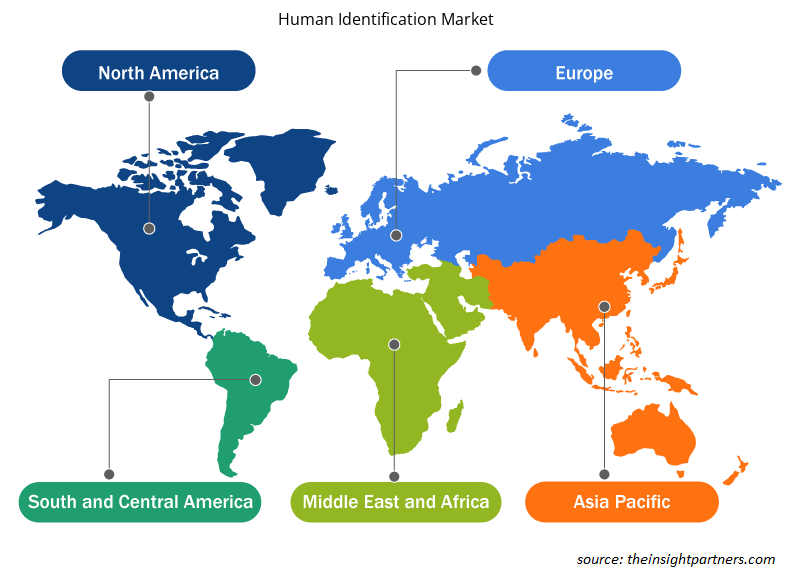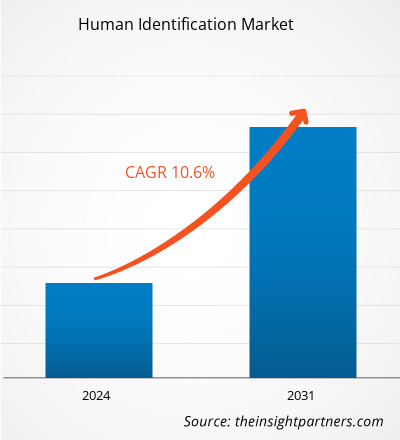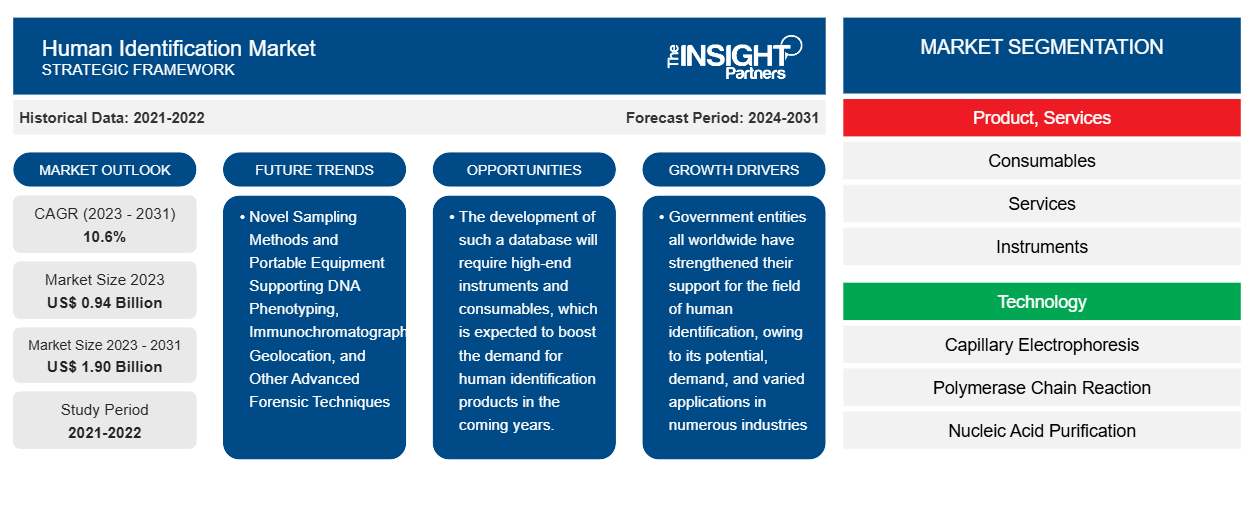Se prevé que el tamaño del mercado de dispositivos de vitrectomía alcance los 1.900 millones de dólares estadounidenses en 2031, frente a los 940 millones de dólares estadounidenses en 2023. Se espera que el mercado registre una CAGR del 10,6 % durante el período 2023-2031. Es probable que la creciente intervención de la tecnología en la ciencia forense siga siendo una tendencia clave en el mercado.
Análisis del mercado de la identificación humana
Se prevé que el aumento de la financiación gubernamental para la ciencia forense en la región y la expansión de la base de datos de ADN de los EE. UU. aceleren el crecimiento del mercado. Además, el creciente apoyo al desarrollo de la ciencia forense y el aumento de las asociaciones entre universidades en esta región de identificación humana están impulsando la expansión del mercado en esta región.
Descripción general del mercado de identificación humana
Las entidades gubernamentales de todo el mundo han fortalecido su apoyo al campo de la identificación humana, debido a su potencial, demanda y variadas aplicaciones en numerosas industrias. El informe del Consejo Nacional de Investigación (NRC) emitido por la Academia Nacional de Ciencias (NAS) en febrero de 2009 sugirió la necesidad de cambios en la ciencia forense en los EE. UU., lo que tuvo un impacto global en este asunto. Muchas disciplinas de la ciencia forense, incluido el análisis de ADN , están transformando a los EE. UU. y al mundo. Se están creando, validando e implementando nuevos enfoques para ayudar a las investigaciones criminales. Los investigadores enfrentan desafíos en términos de validez y precisión de los métodos antiguos y actuales. Además, las familias pueden reunirse con el uso del análisis de ADN forense, especialmente cuando los niños crecen separados de sus padres. La Oficina de Democracia del Departamento de Estado de los EE. UU. está financiando el Proyecto Forense, que tiene como objetivo emplear este método de evaluación con mayor frecuencia para ayudar a las familias reunificadas afectadas por disturbios y otros eventos violentos. Gracias al financiamiento del gobierno federal y del estado de Texas, el Centro de Identificación Humana (CHI) del Centro de Ciencias de la Salud de la Universidad del Norte de Texas en Fort Worth es un centro mundialmente reconocido para pruebas forenses de ADN.
Personalice este informe según sus necesidades
Obtendrá personalización en cualquier informe, sin cargo, incluidas partes de este informe o análisis a nivel de país, paquete de datos de Excel, así como también grandes ofertas y descuentos para empresas emergentes y universidades.
-
Obtenga las principales tendencias clave del mercado de este informe.Esta muestra GRATUITA incluirá análisis de datos, desde tendencias del mercado hasta estimaciones y pronósticos.
Factores impulsores y oportunidades del mercado de identificación humana
Nuevos métodos de muestreo y equipos portátiles que respaldan la fenotipificación del ADN
Los procedimientos basados en la tecnología forense , desde el escaneo de retina hasta el rastreo de la química de la evidencia, ayudan a resolver crímenes de maneras avanzadas. Por ejemplo, las cantidades minúsculas de aceites que quedan en las huellas dactilares pueden revelar la edad general de los sospechosos de un delito, su dieta y si fuman o no. Muchos proyectos de investigación forense se centran en el desarrollo de nuevos instrumentos analíticos, técnicas de evaluación de trazas de evidencia y técnicas de análisis proteómico con procedimientos de muestreo únicos, que permiten la identificación basada en el cabello, la piel y los huesos. Para un análisis exhaustivo en el campo, se han fabricado varios tipos de equipos portátiles. Los instrumentos forenses portátiles resultan útiles para transportar compuestos inestables, perecederos o peligrosos al laboratorio. El fenotipado de ADN es una tecnología avanzada utilizada en las ciencias forenses. Los científicos secuencian una muestra de ADN y proporcionan a los investigadores información sobre las características probables de los sospechosos, como el color del cabello, los ojos y la piel, para identificarlos. La edad y los antecedentes biológicos también se pueden predecir utilizando enfoques más nuevos. El personal también puede utilizar biosensores para analizar los minúsculos rastros de fluidos corporales encontrados en las huellas dactilares para identificar al sospechoso. Los datos detectados con estas muestras incluyen edad, medicación, sexo y estilo de vida.
Potencial sin explotar en las regiones en desarrollo
La expansión del mercado de dispositivos médicos en Asia Pacífico se ve favorecida por el creciente número de programas de financiación, asociaciones público-privadas y respaldo gubernamental. Además, debido a su elevada población geriátrica y a su constante crecimiento demográfico, los países de la región ofrecen importantes oportunidades potenciales para esta industria. China fue el país que más gastó en I+D en el sector sanitario en 2019, según la Organización para la Cooperación y el Desarrollo Económicos (OCDE). La adopción de tecnologías de vanguardia en el sector sanitario se ve facilitada por estas importantes inversiones en su desarrollo. Los gobiernos de varias naciones asiáticas promueven el crecimiento de las empresas autóctonas de dispositivos médicos proporcionándoles exenciones fiscales, terrenos más baratos, incubadoras y otros instrumentos de ayuda, e inversiones directas.
Análisis de segmentación del informe de mercado de identificación humana
Los segmentos clave que contribuyeron a la derivación del análisis del mercado de identificación humana son productos y servicios, tecnología, aplicación y usuario final.
- Según los productos y servicios, el mercado de identificación humana se segmenta en consumibles, servicios, instrumentos y software. El segmento de consumibles tuvo una mayor participación de mercado en 2023.
- Por tecnología, el mercado está segmentado en electroforesis capilar, reacción en cadena de la polimerasa, purificación y extracción de ácidos nucleicos, manipulación automatizada de líquidos, microarrays, secuenciación de próxima generación y análisis rápido de ADN. El segmento de electroforesis capilar tuvo la mayor participación del mercado en 2023.
- Por aplicación, el mercado se segmenta en aplicaciones forenses, identificación de paternidad y otras aplicaciones. El segmento de aplicaciones forenses tuvo la mayor participación del mercado en 2023.
- Por usuario final, el mercado está segmentado en laboratorios forenses, centros de investigación y académicos e institutos gubernamentales. El segmento de laboratorios forenses tuvo la mayor participación del mercado en 2023.
Análisis de la cuota de mercado de la identificación humana por geografía
El alcance geográfico del informe del mercado de identificación humana se divide principalmente en cinco regiones: América del Norte, Asia Pacífico, Europa, Medio Oriente y África, y América del Sur y Central.
Según la Oficina Federal de Investigaciones (FBI), en 2020, 9991 agencias policiales que presentaron datos del Sistema Nacional de Informes Basados en Incidentes (NIBRS) que abarcan el 53% de la población total denunciaron 538.203 incidentes de delitos violentos y 640.836 delitos en los EE. UU.
El FBI reconoce desde hace tiempo las limitaciones de su actual sistema de recopilación de datos y está planeando realizar la transición a un sistema más integral a partir de 2021. El Sistema Nacional de Informes Basados en Incidentes (NIBRS, por sus siglas en inglés) ofrecerá datos sobre un número mucho más significativo de delitos, así como detalles como la hora del día, la ubicación y los tipos de armas involucradas, si corresponde. También proporcionará información demográfica sobre las víctimas, los delincuentes conocidos y los detenidos, como su edad, género, raza y etnia. El Instituto Nacional de Justicia (NIJ, por sus siglas en inglés) anunció una financiación de casi 17 millones de dólares para apoyar 36 proyectos de investigación y desarrollo de ciencias forenses en 2020 en el marco de su programa de I+D en Ciencias Forenses para Fines de Justicia Penal (I+D en Ciencias Forenses). A través de su financiación de subvenciones para I+D, el NIJ sigue impulsando la velocidad, la precisión y la fiabilidad del análisis forense, lo que en última instancia refuerza la administración de justicia.
Perspectivas regionales del mercado de identificación humana
Los analistas de Insight Partners explicaron en detalle las tendencias y los factores regionales que influyen en el mercado de identificación humana durante el período de pronóstico. Esta sección también analiza los segmentos y la geografía del mercado de identificación humana en América del Norte, Europa, Asia Pacífico, Oriente Medio y África, y América del Sur y Central.

- Obtenga los datos regionales específicos para el mercado de identificación humana
Alcance del informe de mercado sobre identificación humana
| Atributo del informe | Detalles |
|---|---|
| Tamaño del mercado en 2023 | 0,94 mil millones de dólares estadounidenses |
| Tamaño del mercado en 2031 | 1.900 millones de dólares estadounidenses |
| CAGR global (2023 - 2031) | 10,6% |
| Datos históricos | 2021-2022 |
| Período de pronóstico | 2024-2031 |
| Segmentos cubiertos |
Por producto, servicios
|
| Regiones y países cubiertos |
América del norte
|
| Líderes del mercado y perfiles de empresas clave |
|
Densidad de actores del mercado: comprensión de su impacto en la dinámica empresarial
El mercado de identificación humana está creciendo rápidamente, impulsado por la creciente demanda de los usuarios finales debido a factores como la evolución de las preferencias de los consumidores, los avances tecnológicos y una mayor conciencia de los beneficios del producto. A medida que aumenta la demanda, las empresas amplían sus ofertas, innovan para satisfacer las necesidades de los consumidores y aprovechan las tendencias emergentes, lo que impulsa aún más el crecimiento del mercado.
La densidad de actores del mercado se refiere a la distribución de las empresas o firmas que operan dentro de un mercado o industria en particular. Indica cuántos competidores (actores del mercado) están presentes en un espacio de mercado determinado en relación con su tamaño o valor total de mercado.
Las principales empresas que operan en el mercado de identificación humana son:
- TERMO FISHER CIENTIFIC INC
- Corporación Promega
- Laboratorios Bio-Rad, Inc.
- QIAGEN
- Compañía General Electric
- Ilumina, Inc.
Descargo de responsabilidad : Las empresas enumeradas anteriormente no están clasificadas en ningún orden particular.

- Obtenga una descripción general de los principales actores clave del mercado de identificación humana
Noticias y desarrollos recientes del mercado de identificación humana
El mercado de identificación humana se evalúa mediante la recopilación de datos cualitativos y cuantitativos a partir de investigaciones primarias y secundarias, que incluyen importantes publicaciones corporativas, datos de asociaciones y bases de datos. A continuación, se enumeran algunos de los avances en el mercado de identificación humana:
- La Oficina del Médico Forense de Denver recibió una subvención federal para comprar un procesador rápido de ADN interno, una tecnología que puede producir resultados de pruebas genéticas en cuestión de horas, lo que agiliza la identificación de víctimas en eventos con víctimas en masa o ayuda a localizar a las familias de cuerpos no identificados. (Fuente: Denver, comunicado de prensa, mayo de 2022)
- QIAGEN completó la adquisición de Verogen, líder en el uso de tecnologías de secuenciación de próxima generación (NGS) para impulsar el futuro de la identificación humana (HID) y la investigación forense. (Fuente: QIAGEN, sitio web de la empresa, enero de 2023)
Cobertura y resultados del informe sobre el mercado de identificación humana
El informe “Tamaño y pronóstico del mercado de identificación humana (2021-2031)” proporciona un análisis detallado del mercado que cubre las siguientes áreas:
- Tamaño del mercado de identificación humana y pronóstico a nivel mundial, regional y nacional para todos los segmentos clave del mercado cubiertos bajo el alcance
- Tendencias del mercado de identificación humana, así como dinámicas del mercado, como impulsores, restricciones y oportunidades clave
- Análisis detallado de las cinco fuerzas de Porter y PEST y FODA
- Análisis del mercado de identificación humana que cubre las tendencias clave del mercado, el marco global y regional, los principales actores, las regulaciones y los desarrollos recientes del mercado.
- Panorama de la industria y análisis de la competencia que abarca la concentración del mercado, análisis de mapas de calor, actores destacados y desarrollos recientes para el mercado de identificación humana
- Perfiles detallados de empresas
- Análisis histórico (2 años), año base, pronóstico (7 años) con CAGR
- Análisis PEST y FODA
- Tamaño del mercado, valor/volumen: global, regional y nacional
- Industria y panorama competitivo
- Conjunto de datos de Excel
Informes recientes
Testimonios
Razón para comprar
- Toma de decisiones informada
- Comprensión de la dinámica del mercado
- Análisis competitivo
- Información sobre clientes
- Pronósticos del mercado
- Mitigación de riesgos
- Planificación estratégica
- Justificación de la inversión
- Identificación de mercados emergentes
- Mejora de las estrategias de marketing
- Impulso de la eficiencia operativa
- Alineación con las tendencias regulatorias























 Obtenga una muestra gratuita para - Mercado de identificación humana
Obtenga una muestra gratuita para - Mercado de identificación humana